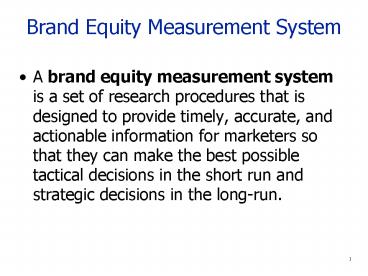Brand Equity Measurement System - PowerPoint PPT Presentation
1 / 12
Title:
Brand Equity Measurement System
Description:
The Knicks. The Fans. The Knicks Brand Charter. Emotional Bond. Uniquely authentic ... An intensely passionate, professional, unparalleled New York City experience. 8 ... – PowerPoint PPT presentation
Number of Views:1179
Avg rating:3.0/5.0
Title: Brand Equity Measurement System
1
Brand Equity Measurement System
- A brand equity measurement system is a set of
research procedures that is designed to provide
timely, accurate, and actionable information for
marketers so that they can make the best possible
tactical decisions in the short run and strategic
decisions in the long-run.
2
Brand Equity Measurement System
- Implementing this system involves
- Conducting brand audits.
- Brand Inventory
- Brand Exploratory
- Developing tracking procedures.
- Designing a brand equity management system
- Brand Equity Charters
- Brand Equity Reports
- Brand Equity Overseers
3
Conducting the Brand Audit
- A brand audit is a comprehensive examination of a
brand involving activities to assess the health
of the brand, uncover its sources of equity and
suggest ways to improve and leverage that equity. - A brand audit requires understanding sources of
brand equity from the perspective of both the
firm and the consumer. - Specifically, the brand audit consists of two
activities - Brand Inventory
- Brand Exploratory
4
Brand Inventory
- The purpose of the brand inventory is to provide
a complete, up-to-date profile of how all the
products and services sold by a company are
marketed and branded. - For each product, the relevant brand elements
must be identified, as well as the supporting
marketing program. This information should be
summarized both visually and verbally. - Although primarily a descriptive exercise, some
useful analysis can be conducted. - Consistency
5
Brand Exploratory
- The brand exploratory is research activity
designed to identify potential sources of brand
equity. - The brand exploratory provides detailed
information as to what consumers think of and
feel about the brand. - Although reviewing past studies and interviewing
relevant personnel provides some insights,
additional research is often required. - To allow a broad range of issues to be covered
and also permit those issues to be pursued
in-depth, qualitative research techniques are
often employed first. - To provide a more specific assessment of the
sources of brand equity, a follow-up quantitative
phase is often necessary.
6
Brand Equity Management SystemThree Steps
- 1. Formalize company position and philosophy into
a Brand Equity Charter to provide relevant
guidelines to marketing managers. - Importance of brands and brand equity
- History of brand
- Brand positioning
- Core brand values
- Core brand promise (brand mantra)
- POP/POD
- Brand guidelines
- Strategic
- Tactical
7
The Knicks Brand Charter
The Knicks
The Fans
Emotional Bond
- Sensory fulfillment
- Looks, feels, and sounds
- Visceral Thrill
- eager anticipation/excitement
- war winning/losing
- Psychological Benefits
- personal identification (with heroes)
- social currency/belonging
- Emotional Awards
- intense experience
- childhood
- sustaining
- exceeds
- Uniquely authentic
- An incomparable event, scene and energy.
- Relentless, resourceful, and tough
- Championship caliber
- A vital part of New York City
- Unlimited in its possibilities
An intensely passionate, professional,
unparalleled New York City experience.
8
Brand Equity Management System Three Steps
- 2.Assemble results of tracking survey and other
relevant outcome measures into a Brand Equity
Report distributed to managers on regular basis - Provides descriptive information as to what is
happening with a brand as well as diagnostic
information as to why
9
Brand Equity Management System Three Steps
- 3. Establish position of VP or Director of Equity
Management to oversee implementation of Brand
Equity Charter and Reports - Ensure that, as much as possible, marketing of
the brand is done in way that reflects the spirit
of the Charter and the substance of the Report
10
Developing Tracking Procedures
- Tracking studies involve information collected
from consumers on a routine basis over time - Often done on a continuous basis
- Provide descriptive and diagnostic information
- Key decisions
- What to track
- Who to track
- When and where to track
- How to interpret tracking studies
11
Understand ROI of Marketing Investments
Marketing Program Investment
Customer Mindset
Market Performance
Shareholder Value
VALUE STAGES
- Awareness - Associations - Attitudes -
Attachment - Activity
- Product - Communications - Trade - Other
- Price premiums - Price elasticities - Market
share - Expansion success - Cost savings -
Profitability
- Stock price - P/E ratio - Market capitalization
12
Brand Value Chain
Market Performance
Shareholder Value
Customer Mindset
Marketing Program Investment
VALUE STAGES
- Price premiums - Price elasticities - Market
share - Expansion success - Cost structure -
Profitability
- - Product
- - Communications
- Trade
- Employee
- - Other
- Awareness - Associations - Attitudes -
Attachment - Activity
- Stock price - P/E ratio - Market capitalization
Program Multiplier
Consumer Multiplier
Market Multiplier
FILTERS
- Clarity
- Relevance
- - Distinctiveness
- - Consistency
- - Channel support
- Consumer size profile
- Competitive reactions
- Market dynamics
- Growth potential
- Risk profile
- Brand contribution































